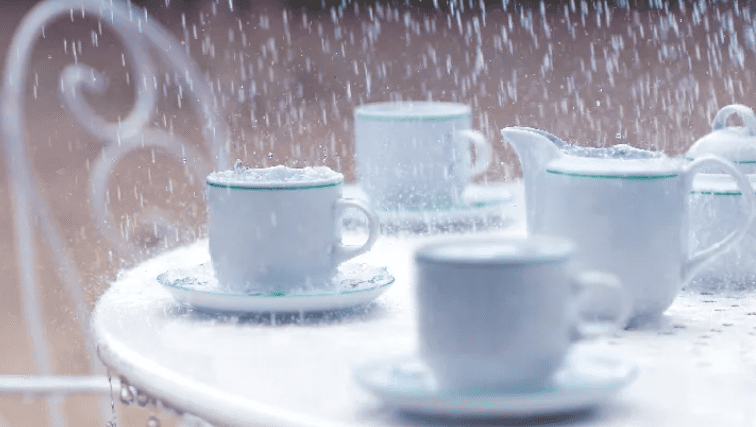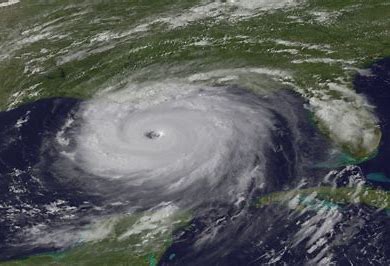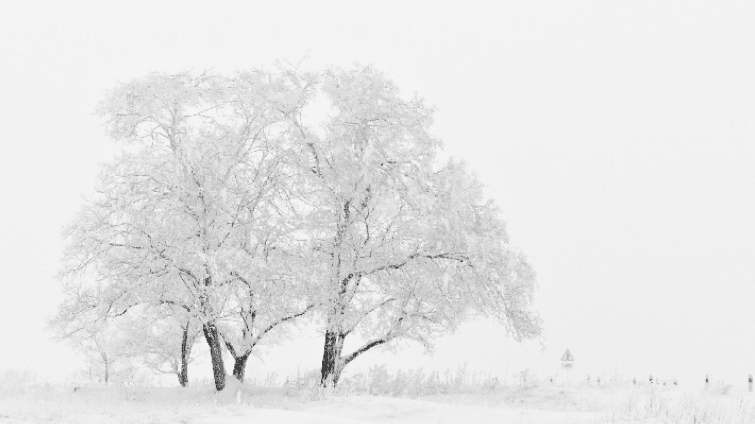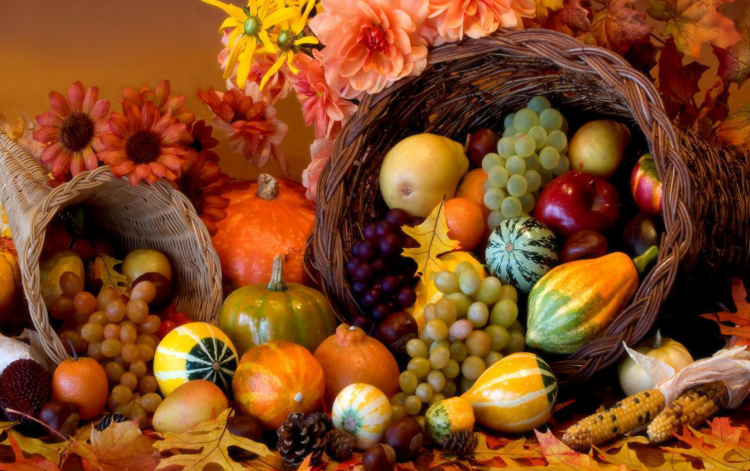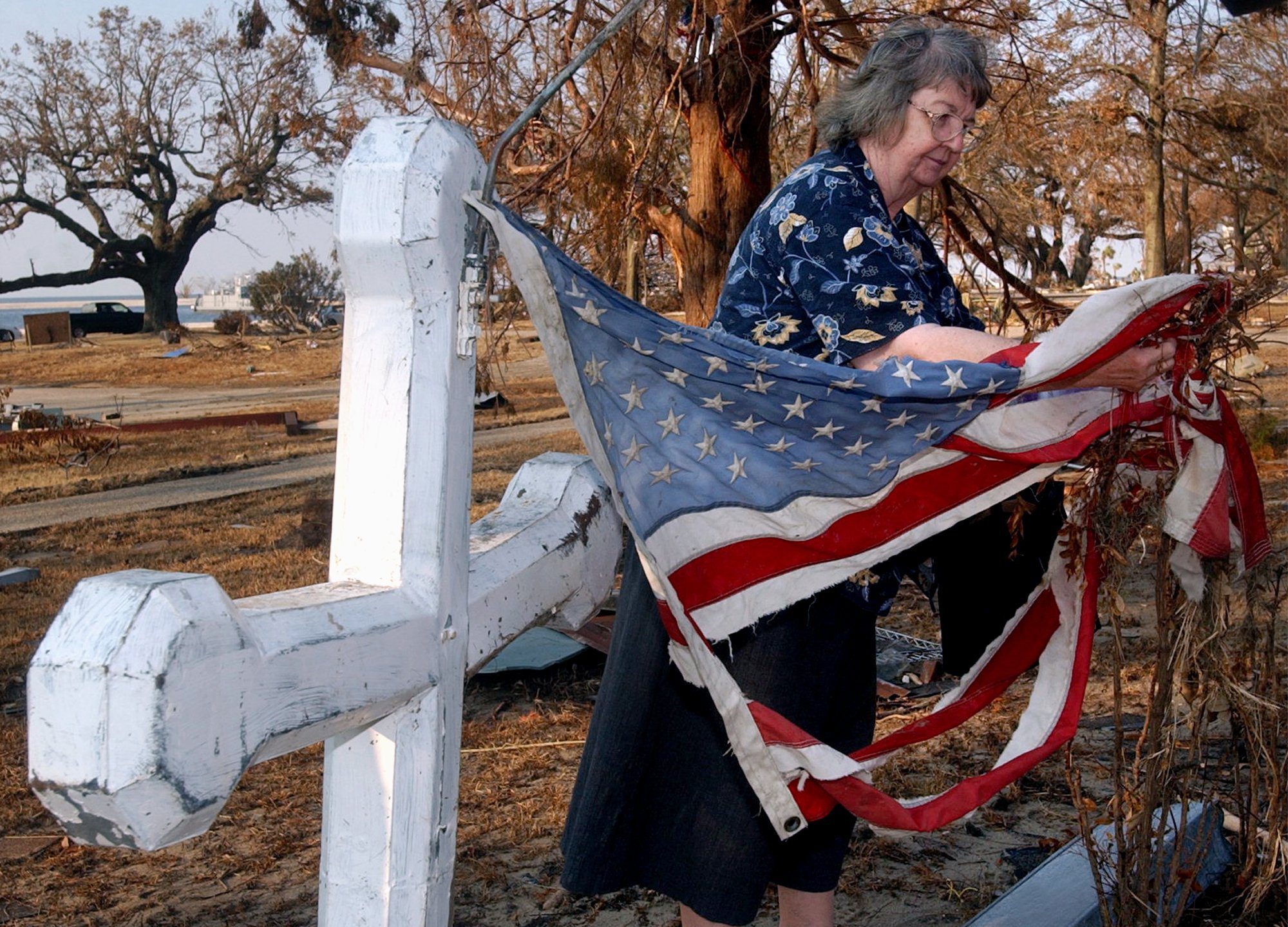
Chloe Guice drapes a tattered U. S. flag on a cross and debris in front of the Episcopal Church of the Redeemer prior to church service in Biloxi Sunday morning. The church and bell tower were demolished by Hurricane Katrina. Guice is the younger sister of the late Wade Guice, who was Civil Defense director during Hurricane Camille in 1969. (Tim Isbell/The Sun Herald)
Photojournalist Tim Isbell says it takes a rare breed of people to weather and survive such a storm as Katrina and the aftermath.
In 1985, Hurricane Elena was heading toward the Mississippi Gulf Coast. I was young and a bit too gung ho about covering the storm. I wanted to be at Ground Zero when the storm hit. It was then that Vernon Matthews said, “It’s my job to keep you alive so you can cover the aftermath.” Twenty years later, Matthews’ words rang true as Hurricane Katrina was churning toward the Mississippi Gulf Coast.
The day before Hurricane Katrina made landfall, I was putting boards on the windows on the north side of my house. I had boarded up the other windows the prior evening. Hurricane Katrina was on her way.
The Sun Herald newsroom had been working nonstop documenting Coast residents preparing for Katrina. After long days of shooting pictures, I often was too tired to do much home preparations. I had to force myself to do so in order for our home to hopefully survive.
As I was putting the final boards on my house, a Gulfport police officer walked up to me. He informed me I was in the mandatory evacuation area and needed to leave.
I told the police officer that I was a photographer with the Sun Herald and my job dictated that I stay on the Coast to document the storm. Before he left, the officer asked for my name. He said he needed it for my toe tag. That was my early introduction to Hurricane Katrina.
I had every intention of staying for the storm. After I was told by the building manager that only essential personnel were needed at the paper, I decided to personally drive Judy and Patrick to safety in Pearl, Miss.
Even with press credentials, I wasn’t allowed to drive back to the Coast until a day after the storm. The issue with taking someone to safety north of the Coast was one had to drive back through the storm to return.
When I did get back to the Coast, I immediately went to work. The first thing I did was check my house. David Purdy had shot aerials and he told me my house was standing. That was a relief.
Upon my first inspection of my house it was like Swiss Family Robinson. It was covered by four downed trees. There were ten more downed trees in my backyard.

At my first assignment, photographer Marianne DuBose saw me. She asked how I was doing. My reply was “It’s hard to take pictures with tears in your eyes.”
My camera has always been my shield when covering disturbing stories. That shield didn’t work after Katrina. This was personal. Katrina attacked my home, my family, and friends.
One of my neighbors was a lineman for Mississippi Power Company. A couple days after Katrina, he drove to the end of the street and hooked us back up to the electrical grid. I called Judy in Pearl and said “Guess what I have.” When I told her we had power and most importantly air conditioning. Judy said, “We’re coming home.”
It was important to me to have Judy and Patrick away during the storm. I figured I’d do better work if I knew they were safe. Once the storm was over, it was important to have them home. They were a means of support.
When we covered Katrina victims, they needed to share their experiences. We often stayed longer on assignments so the victims could just talk.
While I tried to do my best in trying times at the paper, I also felt an obligation to my friends and colleagues. I provided shelter for my friends and fellow photographers. David and Heather Purdy, along with their dogs, stayed in our house. So did John and Sharon Fitzhugh. We were sort of like the photographic storm-ravaged Waltons.
Once any family got power restored, they would head back home. Giving shelter was just the decent thing to do.
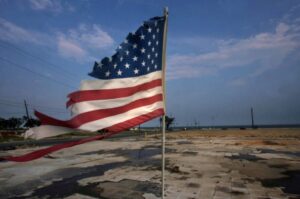
When the Sun Herald won the Pulitzer Prize for its coverage of Hurricane Katrina and the aftermath, I said, “I’d trade the Pulitzer for Katrina to have never hit the Mississippi Gulf Coast.” I still stand by my statement. While I am proud of the Sun Herald, our news coverage and the strength of the people of the Mississippi Gulf Coast, hurricanes are like a thief in the night that robs something from the area it hits. It can be a piece of history forever washed away or a promising life taken from us. It takes a rare breed of people to weather and survive such a storm as Katrina and the aftermath.
While I know I can’t totally wipe Katrina from my mind, I have tried to forget the ravages of the storm. Once while taking pictures in east Biloxi, a pickup pulling a trailer was still moving bodies. The whole East End smelled like death. Perfectly normal people walked around this post-apocalyptic landscape like zombies totally stunned by Katrina’s wrath.
I found later on that one of my Katrina triggers was the smell of peanut butter. At the time of Katrina, I survived on peanut butter crackers. I’d shove a bunch in my pockets to be my food supply while covering the aftermath. Many times, I gave the crackers to the victims already starting to rebuild in one way or another.
Years later, a tornado ravaged Hattiesburg and the campus of Southern Miss. I wanted to pass some wisdom to the younger photojournalists covering the aftermath of that storm. I told them, “For the first few days, you’ll be running a sprint. At some point, you’ll realize you’re going to cover that tornado for years to come. At that point, you’re no longer running a sprint, but a marathon.” A smart journalist will realize this and adjust. With storms like Katrina, adjusting is just one of the norms of covering such a life-altering event.
#####

